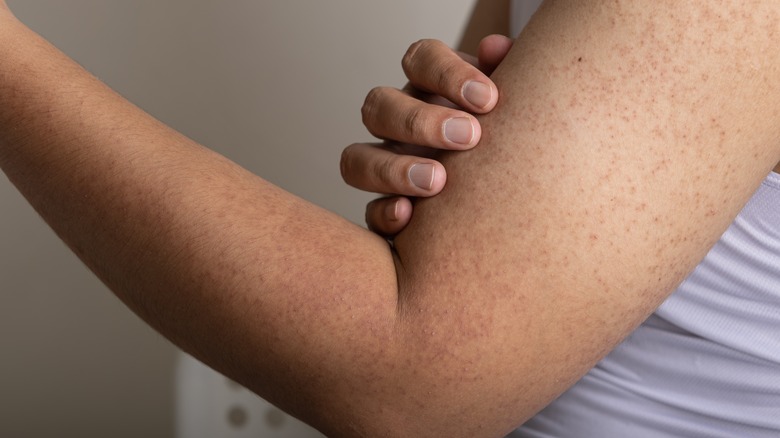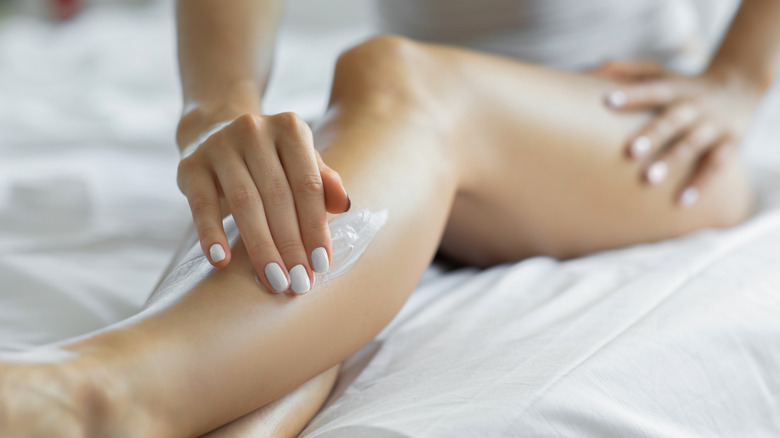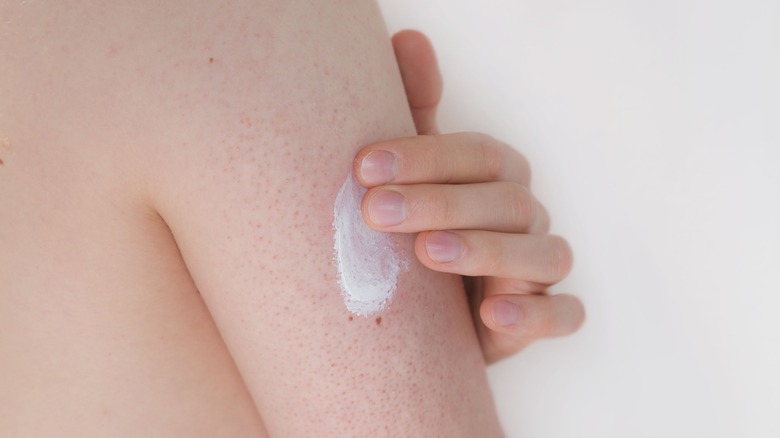KP Treatments Are A Dime A Dozen, But How Do You Actually Prevent Annoying Strawberry Skin?
It's bad enough that you have to shave your legs repeatedly to keep them clear and smooth, but you know those unsightly red, pimple-like bumps that pop up all over your legs — or even arms — a few days after shaving? There's apparently a name for that, and no, it's not chicken skin or even strawberry skin, although that sounds far more appealing.
Dr. Sarah Villafranco explained to MBG that it's actually keratosis pilaris, or KP. While it looks like acne, it's far from that. The tiny bumps develop near the opening of hair follicles, leading to skin that looks and feels prickly. "Keratosis just means an excess of growth of keratin, one of the proteins that make up our skin and hair. And any medical word with 'pilo' in it is related to hair," she said. "So, keratosis pilaris is a buildup of keratin and dead skin cells within the hair follicles, causing them to bulge, giving them the bumpy texture, and often causing them to get irritated and inflamed."
Fortunately, KP tends to go away on its own as you grow older, but unfortunately, there's nothing much you can do to keep it from developing on your skin's surface. However, just because keratosis pilaris isn't preventable and curable, that doesn't mean that you can't do anything to keep it at bay. Because the condition affects a considerable chunk of the population, there are a number of tested and proven treatment options you can try to banish chicken skin.
There are ways to temporarily eradicate strawberry skin
Unlike most skin conditions, keratosis pilaris is generally harmless, so you don't have to worry about experiencing any discomfort when it manifests itself on your skin. It's understandably a nuisance, though, especially if you're trying to keep your skin as clear as possible. One thing you can try in terms of treatment is exfoliation, but not the physical kind. In fact, it was found that people with keratosis pilaris who try to treat their strawberry skin through exfoliation only exacerbate the condition.
"We used to think if you exfoliated enough, you'd be able to undo KP," dermatologist Doris Day shared with Allure. "But exfoliating can actually irritate the bumps and make them much worse." Dermatologist Dr. Kenneth Beer added, "There isn't a permanent fix, but you can make the bumps go away for a while with glycolic and lactic acid treatments, which will diminish buildup and make your skin feel softer."
Mayo Clinic also suggests trying retinol, since it's known to accelerate cell renewal and can therefore prevent clogging pores and hair follicles. If you want the natural route, soaking the affected area in warm water can help loosen pores, minimizing the appearance of the bumps.
It's all your parents' fault
You're not alone in dealing with KP. Cleveland Clinic noted that it's a fairly common condition experienced by 50 to 80 percent of teenagers and 40 percent of adults. Keratosis pilaris is not preventable because of the very fact that it's inherited. You don't get strawberry skin because you shave every other day or you pick at your arms and legs too much (note: don't do that). You get it because you're predisposed to it. "The tendency to develop keratosis pilaris has genetic origins. Up to half of the children of an affected individual may display signs of keratosis pilaris to a variable degree," Dr. Simon Zokaie, a cosmetic dermatologist, told Woman and Home.
In other words, it's not you, it's your parents. And even though there's no known cure for it, just make sure that you practice consistency with whatever treatment you decide to try, unless you want strawberry skin to return with a vengeance. "You have to be good about putting these products on at least twice a day because, when you stop, it typically comes back," dermatologist Dr. Marisa Garshick pointed out to NBC News.


